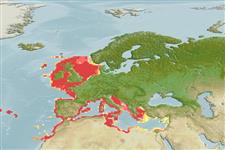Common names from other countries
Environment: milieu / climate zone / depth range / distribution range
Ecologia
; intervalo de profundidade 5 - 200 m (Ref. 85369), usually 10 - 70 m (Ref. 4). Subtropical; 12°C - 16°C (Ref. 114562), preferred 11°C (Ref. 107945); 61°N - 27°N, 32°W - 36°E (Ref. 114562)
Eastern Atlantic and the Mediterranean: from Norway to Morocco. Subtropical to temperate.
Length at first maturity / Tamanho / Peso / Idade
Maturity: Lm 10.0, range 7 - 8 cm Max length : 50.0 cm TL macho/indeterminado; (Ref. 441); common length : 40.0 cm BASL macho/indeterminado; (Ref. 441); Idade máx. registada: 15 anos (Ref. 85318)
Traditionally caught by traps, pots and sometimes by hand (e.g., diving and spearing; Refs. 441, 85369), but these gears were eventually replaced with trammel nets (Ref. 85369). Minimum depth from Ref. 4. Occurs at depths between shore to 200 m, on rocky bottoms and coralligenous substrates where there are lots of protective holes and micro-caves. Adults may be solitary, in pairs or in small groups. Highly omnivorous and preys on hard-shelled bottom dwelling organisms, i.e., mollusks, echinoderms and crustaceans. They are generalists and opportunistic feeders depending on the abundance of benthic organisms (Ref. 85369). Ovigerous females are observed from September to October and February to March (Ref. 4).
Breeds once a year between June and October. Larger females mate and lay eggs earlier during breeding season while smaller females spawn towards the end (Ref. 85364).
Holthuis, L.B. 1991. (Ref. 4)
Categoria na Lista Vermelha da IUCN (Ref. 130435)
Categoria CITES (Ref. 108899)
Not Evaluated
Not Evaluated
Utilização humana
Pescarias: espécies comerciais
FAO - pescarias: landings | FishSource | Sea Around Us
Ferramentas
Fontes da internet
Estimates based on models
Preferred temperature
(Ref.
115969): 7.7 - 19.6, mean 11.9 (based on 808 cells).
Resiliência
Médio, tempo mínimo de duplicação da população 1,4 - 4,4 anos (K=0.13-0.21; tm=4; tmax=15).
Prior r = 0.22, 95% CL = 0.14 - 0.33, Based on 4 data-limited stock assessments.
Vulnerabilidade
Moderate vulnerability (40 of 100).
